Hydrocortisone (Oral)
Editor-In-Chief: C. Michael Gibson, M.S., M.D. [1]; Associate Editor(s)-in-Chief: Adeel Jamil, M.D. [2]
Disclaimer
WikiDoc MAKES NO GUARANTEE OF VALIDITY. WikiDoc is not a professional health care provider, nor is it a suitable replacement for a licensed healthcare provider. WikiDoc is intended to be an educational tool, not a tool for any form of healthcare delivery. The educational content on WikiDoc drug pages is based upon the FDA package insert, National Library of Medicine content and practice guidelines / consensus statements. WikiDoc does not promote the administration of any medication or device that is not consistent with its labeling. Please read our full disclaimer here.
Overview
Hydrocortisone (Oral) is a anti inflammatory and glucocorticoid that is FDA approved for the treatment of allergic states, asthma, serum sickness, transfusion reactions, bullous dermatitis herpetiformis, severe erythema multiforme, adrenocortical insufficiency, congenital adrenal hyperplasia, nonsuppurative thyroiditis, ulcerative colitis, hemolytic anemia, idiopathic thrombocytopenic purpura, multiple sclerosis, lupus erythematosus, sarcoidosis, acute gouty arthritis, rheumatoid arthritis, temporal arteritis, polymyositis, and systemic lupus erythematosus. Common adverse reactions include nausea, peptic ulcer, depression, emotional instability, euphoria, headache, acne, allergic dermatitis, burning or tingling, cutaneous and subcutaneous atrophy, syncope, tachycardia, hypertension, weight gain, abdominal distention, fluid retention, edema, hypokalemic alkalosis, and muscle weakness.
Adult Indications and Dosage
FDA-Labeled Indications and Dosage (Adult)
- CORTEF Tablets are indicated in the following conditions.
Endocrine Disorders
- Primary or secondary adrenocortical insufficiency (hydrocortisone or cortisone is the first choice; synthetic analogs may be used in conjunction with mineralocorticoids where applicable; in infancy mineralocorticoid supplementation is of particular importance)
- Congenital adrenal hyperplasia
- Non suppurative thyroiditis
- Hypercalcemia associated with cancer
Rheumatic Disorders
- As adjunctive therapy for short-term administration (to tide the patient over an acute episode or exacerbation) in:
- Psoriatic arthritis
- Rheumatoid arthritis, including juvenile rheumatoid arthritis (selected cases may require low-dose maintenance therapy)
- Ankylosing spondylitis
- Acute and subacute bursitis
- Acute nonspecific tenosynovitis
- Acute gouty arthritis
- Post-traumatic osteoarthritis
- Synovitis of osteoarthritis
- Epicondylitis
Collagen Diseases
- During an exacerbation or as maintenance therapy in selected cases of:
- Systemic lupus erythematosus
- Systemic dermatomyositis (polymyositis)
- Acute rheumatic carditis
Dermatologic Diseases
- Pemphigus
- Bullous dermatitis herpetiformis
- Severe erythema multiforme (Stevens-Johnson syndrome)
- Exfoliative dermatitis
- Mycosis fungoides
- Severe psoriasis
- Severe seborrheic dermatitis
Allergic States
- Control of severe or incapacitating allergic conditions intractable to adequate trials of conventional treatment:
- Seasonal or perennial allergic rhinitis
- Serum sickness
- Bronchial asthma
- Contact dermatitis
- Atopic dermatitis
- Drug hypersensitivity reactions
Ophthalmic Diseases
- Severe acute and chronic allergic and inflammatory processes involving the eye and its adnexa such as:
- Allergic conjunctivitis
- Keratitis
- Allergic corneal marginal ulcers
- Herpes zoster ophthalmicus
- Iritis and iridocyclitis
- Chorioretinitis
- Anterior segment inflammation
- Diffuse posterior uveitis and choroiditis
- Optic neuritis
- Sympathetic ophthalmia
Respiratory Diseases
- Symptomatic sarcoidosis
- Loeffler's syndrome not manageable by other means
- Berylliosis
- Fulminating or disseminated pulmonary tuberculosis when used concurrently with appropriate antituberculous chemotherapy
- Aspiration pneumonitis
Hematologic Disorders
- Idiopathic thrombocytopenic purpura in adults
- Secondary thrombocytopenia in adults
- Acquired (autoimmune) hemolytic anemia
- Erythroblastopenia (RBC anemia)
- Congenital (erythroid) hypoplastic anemia
Neoplastic Diseases
- For palliative management of:
- Leukemias and lymphomas in adults
- Acute leukemia of childhood
Edematous States
- To induce a diuresis or remission of proteinuria in the nephrotic syndrome, without uremia, of the idiopathic type or that due to lupus erythematosus.
Gastrointestinal Diseases
- To tide the patient over a critical period of the disease in:
- Ulcerative colitis
- Regional enteritis
Nervous System
- Acute exacerbations of multiple sclerosis
Miscellaneous
- Tuberculous meningitis with subarachnoid block or impending block when used concurrently with appropriate antituberculous chemotherapy
- Trichinosis with neurologic or myocardial involvement
Dosing Information
- The initial dosage of CORTEF Tablets may vary from 20 mg to 240 mg of hydrocortisone per day depending on the specific disease entity being treated. In situations of less severity lower doses will generally suffice while in selected patients higher initial doses may be required. The initial dosage should be maintained or adjusted until a satisfactory response is noted. If after a reasonable period of time there is a lack of satisfactory clinical response, CORTEF should be discontinued and the patient transferred to other appropriate therapy. IT SHOULD BE EMPHASIZED THAT DOSAGE REQUIREMENTS ARE VARIABLE AND MUST BE INDIVIDUALIZED ON THE BASIS OF THE DISEASE UNDER TREATMENT AND THE RESPONSE OF THE PATIENT. After a favorable response is noted, the proper maintenance dosage should be determined by decreasing the initial drug dosage in small decrements at appropriate time intervals until the lowest dosage which will maintain an adequate clinical response is reached. It should be kept in mind that constant monitoring is needed in regard to drug dosage. Included in the situations which may make dosage adjustments necessary are changes in clinical status secondary to remissions or exacerbations in the disease process, the patient's individual drug responsiveness, and the effect of patient exposure to stressful situations not directly related to the disease entity under treatment; in this latter situation it may be necessary to increase the dosage of CORTEF for a period of time consistent with the patient's condition. If after long-term therapy the drug is to be stopped, it is recommended that it be withdrawn gradually, rather than abruptly.
Multiple Sclerosis
- In treatment of acute exacerbations of multiple sclerosis, daily doses of 200 mg of prednisolone for a week followed by 80 mg every other day for 1 month have been shown to be effective (20 mg of hydrocortisone is equivalent to 5 mg of prednisolone).
Off-Label Use and Dosage (Adult)
Guideline-Supported Use
There is limited information regarding Off-Label Guideline-Supported Use of Hydrocortisone (Oral) in adult patients.
Non–Guideline-Supported Use
There is limited information regarding Off-Label Non–Guideline-Supported Use of Hydrocortisone (Oral) in adult patients.
Pediatric Indications and Dosage
FDA-Labeled Indications and Dosage (Pediatric)
There is limited information regarding Hydrocortisone (Oral) FDA-Labeled Indications and Dosage (Pediatric) in the drug label.
Off-Label Use and Dosage (Pediatric)
Guideline-Supported Use
There is limited information regarding Off-Label Guideline-Supported Use of Hydrocortisone (Oral) in pediatric patients.
Non–Guideline-Supported Use
There is limited information regarding Off-Label Non–Guideline-Supported Use of Hydrocortisone (Oral) in pediatric patients.
Contraindications
- Systemic fungal infections and known hypersensitivity to components
Warnings
- In patients on corticosteroid therapy subjected to unusual stress, increased dosage of rapidly acting corticosteroids before, during, and after the stressful situation is indicated.
- Corticosteroids may mask some signs of infection, and new infections may appear during their use. Infections with any pathogen including viral, bacterial, fungal, protozoan or helminthic infections, in any location of the body, may be associated with the use of corticosteroids alone or in combination with other immunosuppressive agents that affect cellular immunity, humoral immunity, or neutrophil function.1
- These infections may be mild, but can be severe and at times fatal. With increasing doses of corticosteroids, the rate of occurrence of infectious complications increases.2 There may be decreased resistance and inability to localize infection when corticosteroids are used.
- Prolonged use of corticosteroids may produce posterior subcapsular cataracts, glaucoma with possible damage to the optic nerves, and may enhance the establishment of secondary ocular infections due to fungi or viruses.
- Average and large doses of hydrocortisone or cortisone can cause elevation of blood pressure, salt and water retention, and increased excretion of potassium. These effects are less likely to occur with the synthetic derivatives except when used in large doses. Dietary salt restriction and potassium supplementation may be necessary. All corticosteroids increase calcium excretion.
- Administration of live or live, attenuated vaccines is contraindicated in patients receiving immunosuppressive doses of corticosteroids. Killed or inactivated vaccines may be administered to patients receiving immunosuppressive doses of corticosteroids; however, the response to such vaccines may be diminished. Indicated immunization procedures may be undertaken in patients receiving nonimmunosuppressive doses of corticosteroids.
- The use of CORTEF Tablets in active tuberculosis should be restricted to those cases of fulminating or disseminated tuberculosis in which the corticosteroid is used for the management of the disease in conjunction with an appropriate antituberculous regimen.
- If corticosteroids are indicated in patients with latent tuberculosis or tuberculin reactivity, close observation is necessary as reactivation of the disease may occur. During prolonged corticosteroid therapy, these patients should receive chemoprophylaxis.
- Persons who are on drugs which suppress the immune system are more susceptible to infections than healthy individuals. Chicken pox and measles, for example, can have a more serious or even fatal course in non-immune children or adults on corticosteroids. In such children or adults who have not had these diseases, particular care should be taken to avoid exposure. How the dose, route and duration of corticosteroid administration affects the risk of developing a disseminated infection is not known. The contribution of the underlying disease and/or prior corticosteroid treatment to the risk is also not known. If exposed to chicken pox, prophylaxis with varicella zoster immune globulin (VZIG) may be indicated. If exposed to measles, prophylaxis with pooled intramuscular immunoglobulin (IG) may be indicated. (See the respective package inserts for complete VZIG and IG prescribing information.) If chicken pox develops, treatment with antiviral agents may be considered. Similarly, corticosteroids should be used with great care in patients with known or suspected Strongyloides (threadworm) infestation. In such patients, corticosteroid-induced immunosuppression may lead to Strongyloides hyperinfection and dissemination with widespread larval migration, often accompanied by severe enterocolitis and potentially fatal gram-negative septicemia.
PRECAUTIONS
General Precautions
- Drug-induced secondary adrenocortical insufficiency may be minimized by gradual reduction of dosage. This type of relative insufficiency may persist for months after discontinuation of therapy; therefore, in any situation of stress occurring during that period, hormone therapy should be reinstituted. Since mineralocorticoid secretion may be impaired, salt and/or a mineralocorticoid should be administered concurrently.
- There is an enhanced effect of corticosteroids on patients with hypothyroidism and in those with cirrhosis.
- Corticosteroids should be used cautiously in patients with ocular herpes simplex because of possible corneal perforation.
- The lowest possible dose of corticosteroid should be used to control the condition under treatment, and when reduction in dosage is possible, the reduction should be gradual.
- Psychic derangements may appear when corticosteroids are used, ranging from euphoria, insomnia, mood swings, personality changes, and severe depression, to frank psychotic manifestations. Also, existing emotional instability or psychotic tendencies may be aggravated by corticosteroids.
- Steroids should be used with caution in nonspecific ulcerative colitis, if there is a probability of impending perforation, abscess or other pyogenic infection; diverticulitis; fresh intestinal anastomoses; active or latent peptic ulcer; renal insufficiency; hypertension; osteoporosis; and myasthenia gravis.
- Growth and development of infants and children on prolonged corticosteroid therapy should be carefully observed.
- Kaposi's sarcoma has been reported to occur in patients receiving corticosteroid therapy. Discontinuation of corticosteroids may result in clinical remission.
- Although controlled clinical trials have shown corticosteroids to be effective in speeding the resolution of acute exacerbations of multiple sclerosis, they do not show that corticosteroids affect the ultimate outcome or natural history of the disease. The studies do show that relatively high doses of corticosteroids are necessary to demonstrate a significant effect.
- Since complications of treatment with glucocorticoids are dependent on the size of the dose and the duration of treatment, a risk/benefit decision must be made in each individual case as to dose and duration of treatment and as to whether daily or intermittent therapy should be used.
Adverse Reactions
Clinical Trials Experience
- Fluid and Electrolyte Disturbances
- Sodium retention
- Fluid retention
- Congestive heart failure in susceptible patients
- Potassium loss
- Hypokalemic alkalosis
- Hypertension
Musculoskeletal
- Muscle weakness
- Steroid myopathy
- Loss of muscle mass
- Osteoporosis
- Tendon rupture, particularly of the Achilles tendon
- Vertebral compression fractures
- Aseptic necrosis of femoral and humeral heads
- Pathologic fracture of long bones
Gastrointestinal
- Peptic ulcer with possible perforation and hemorrhage
- Pancreatitis
- Abdominal distention
- Ulcerative esophagitis
- Increases in alanine transaminase (ALT, SGPT), aspartate transaminase (AST, SGOT) and alkaline phosphatase have been observed following corticosteroid treatment. These changes are usually small, not associated with any clinical syndrome and are reversible upon discontinuation.
Dermatologic
- Impaired wound healing
- Thin fragile skin
- Petechiae and ecchymoses
- Facial erythema
- Increased sweating
- May suppress reactions to skin tests
Neurological
- Increased intracranial pressure with papilledema (pseudotumor cerebri) usually after treatment
- Convulsions
- Vertigo
- Headache
Endocrine
- Development of Cushingoid state
- Suppression of growth in children
- Secondary adrenocortical and pituitary unresponsiveness, particularly in times of stress, as in trauma, surgery or illness
- Menstrual irregularities
- Decreased carbohydrate tolerance
- Manifestations of latent diabetes mellitus
- Increased requirements for insulin or oral hypoglycemic agents in diabetics
Ophthalmic
- Posterior subcapsular cataracts
- Increased intraocular pressure
- Glaucoma
- Exophthalmos
Metabolic
- Negative nitrogen balance due to protein catabolism
Postmarketing Experience
There is limited information regarding Hydrocortisone (Oral) Postmarketing Experience in the drug label.
Drug Interactions
- The pharmacokinetic interactions listed below are potentially clinically important. Drugs that induce hepatic enzymes such as phenobarbital, phenytoin and rifampin may increase the clearance of corticosteroids and may require increases in corticosteroid dose to achieve the desired response. Drugs such as troleandomycin and ketoconazole may inhibit the metabolism of corticosteroids and thus decrease their clearance. Therefore, the dose of corticosteroid should be titrated to avoid steroid toxicity. Corticosteroids may increase the clearance of chronic high dose aspirin. This could lead to decreased salicylate serum levels or increase the risk of salicylate toxicity when corticosteroid is withdrawn. Aspirin should be used cautiously in conjunction with corticosteroids in patients suffering from hypoprothrombinemia. The effect of corticosteroids on oral anticoagulants is variable. There are reports of enhanced as well as diminished effects of anticoagulants when given concurrently with corticosteroids. Therefore, coagulation indices should be monitored to maintain the desired anticoagulant effect.
Use in Specific Populations
Pregnancy
- Since adequate human reproduction studies have not been done with corticosteroids, the use of these drugs in pregnancy, nursing mothers or women of childbearing potential requires that the possible benefits of the drug be weighed against the potential hazards to the mother and embryo or fetus. Infants born of mothers who have received substantial doses of corticosteroids during pregnancy, should be carefully observed for signs of hypoadrenalism.
Pregnancy Category (AUS):
There is no Australian Drug Evaluation Committee (ADEC) guidance on usage of Hydrocortisone (Oral) in women who are pregnant.
Labor and Delivery
There is no FDA guidance on use of Hydrocortisone (Oral) during labor and delivery.
Nursing Mothers
There is no FDA guidance on the use of Hydrocortisone (Oral) in women who are nursing.
Pediatric Use
There is no FDA guidance on the use of Hydrocortisone (Oral) in pediatric settings.
Geriatic Use
There is no FDA guidance on the use of Hydrocortisone (Oral) in geriatric settings.
Gender
There is no FDA guidance on the use of Hydrocortisone (Oral) with respect to specific gender populations.
Race
There is no FDA guidance on the use of Hydrocortisone (Oral) with respect to specific racial populations.
Renal Impairment
There is no FDA guidance on the use of Hydrocortisone (Oral) in patients with renal impairment.
Hepatic Impairment
There is no FDA guidance on the use of Hydrocortisone (Oral) in patients with hepatic impairment.
Females of Reproductive Potential and Males
There is no FDA guidance on the use of Hydrocortisone (Oral) in women of reproductive potentials and males.
Immunocompromised Patients
There is no FDA guidance one the use of Hydrocortisone (Oral) in patients who are immunocompromised.
Administration and Monitoring
Administration
- Oral
Monitoring
There is limited information regarding Hydrocortisone (Oral) Monitoring in the drug label.
IV Compatibility
There is limited information regarding the compatibility of Hydrocortisone (Oral) and IV administrations.
Overdosage
There is limited information regarding Hydrocortisone (Oral) overdosage. If you suspect drug poisoning or overdose, please contact the National Poison Help hotline (1-800-222-1222) immediately.
Pharmacology
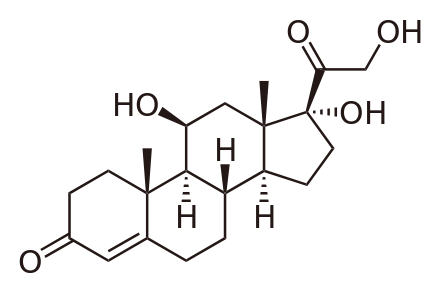 | |
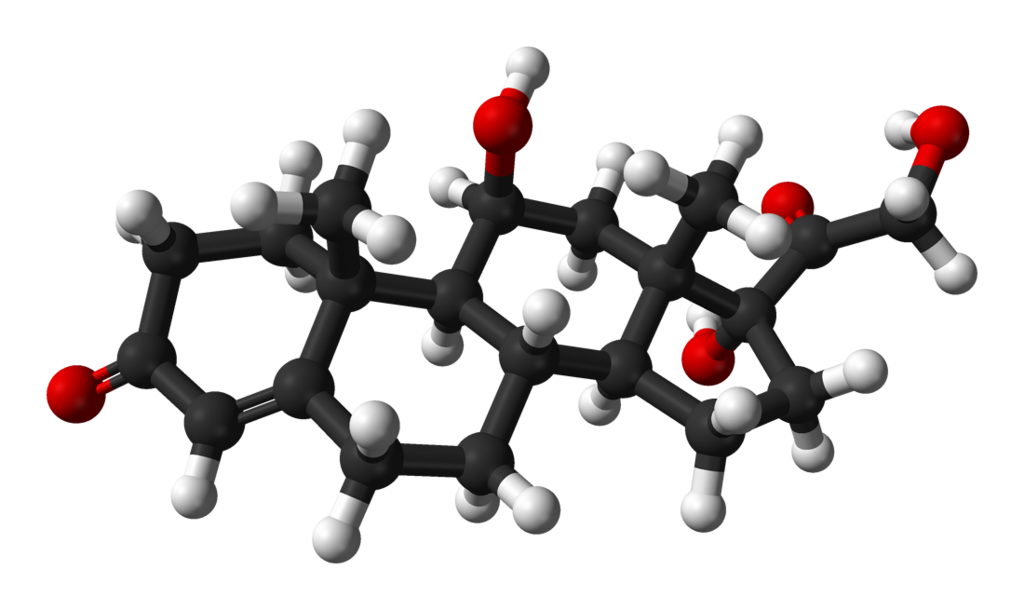 | |
| Clinical data | |
|---|---|
| AHFS/Drugs.com | Monograph |
| MedlinePlus | a682206 |
| [[Regulation of therapeutic goods |Template:Engvar data]] |
|
| Pregnancy category | |
| Routes of administration | Oral tablets, intravenous, topical, rectal |
| ATC code | |
| Legal status | |
| Legal status |
|
| Identifiers | |
| |
| CAS Number | |
| PubChem CID | |
| DrugBank | |
| ChemSpider | |
| UNII | |
| KEGG | |
| ChEBI | |
| ChEMBL | |
| E number | {{#property:P628}} |
| ECHA InfoCard | {{#property:P2566}}Lua error in Module:EditAtWikidata at line 36: attempt to index field 'wikibase' (a nil value). |
| Chemical and physical data | |
| Formula | C21H30O5 |
| Molar mass | 362.460 g/mol |
| 3D model (JSmol) | |
| |
| |
| | |
Mechanism of Action
- Naturally occurring glucocorticoids (hydrocortisone and cortisone), which also have salt-retaining properties, are used as replacement therapy in adrenocortical deficiency states. Their synthetic analogs are primarily used for their potent anti-inflammatory effects in disorders of many organ systems.
- Glucocorticoids cause profound and varied metabolic effects. In addition, they modify the body's immune responses to diverse stimuli.
Structure
- CORTEF Tablets contain hydrocortisone which is a glucocorticoid. Glucocorticoids are adrenocortical steroids, both naturally occurring and synthetic, which are readily absorbed from the gastrointestinal tract. Hydrocortisone USP is white to practically white, odorless, crystalline powder with a melting point of about 215° C. It is very slightly soluble in water and in ether; sparingly soluble in acetone and in alcohol; slightly soluble in chloroform.
- The chemical name for hydrocortisone is pregn-4-ene-3,20-dione,11,17,21-trihydroxy-, (11β)-. Its molecular weight is 362.46 and the structural formula is as outlined below.
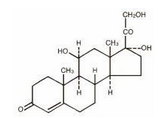
Pharmacodynamics
There is limited information regarding Hydrocortisone (Oral) Pharmacodynamics in the drug label.
Pharmacokinetics
There is limited information regarding Hydrocortisone (Oral) Pharmacokinetics in the drug label.
Nonclinical Toxicology
There is limited information regarding Hydrocortisone (Oral) Nonclinical Toxicology in the drug label.
Clinical Studies
There is limited information regarding Hydrocortisone (Oral) Clinical Studies in the drug label.
How Supplied
CORTEF Tablets are available in the following strengths and package sizes:
5 mg (white, round, scored, imprinted CORTEF 5) Bottles of 50 NDC 0009-0012-01
10 mg (white, round, scored, imprinted CORTEF 10) Bottles of 100 NDC 0009-0031-01
20 mg (white, round, scored, imprinted CORTEF 20) Bottles of 100 NDC 0009-0044-01
Storage
- Store at controlled room temperature 20° to 25°C (68° to 77°F) [see USP].
Images
Drug Images
{{#ask: Page Name::Hydrocortisone (Oral) |?Pill Name |?Drug Name |?Pill Ingred |?Pill Imprint |?Pill Dosage |?Pill Color |?Pill Shape |?Pill Size (mm) |?Pill Scoring |?NDC |?Drug Author |format=template |template=DrugPageImages |mainlabel=- |sort=Pill Name }}
Package and Label Display Panel
PRINCIPAL DISPLAY PANEL - 5 MG BOTTLE LABEL
NDC 0009-0012-01
Pfizer
Cortef® hydrocortisone tablets, USP
5 mg
50 Tablets Rx only
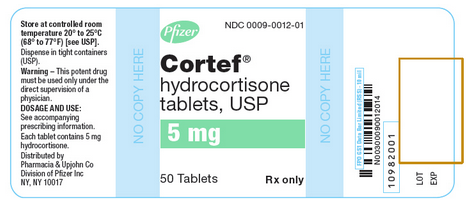
PRINCIPAL DISPLAY PANEL - 10 MG BOTTLE LABEL
NDC 0009-0031-01
Pfizer
Cortef® hydrocortisone tablets, USP
10 mg
100 Tablets Rx only
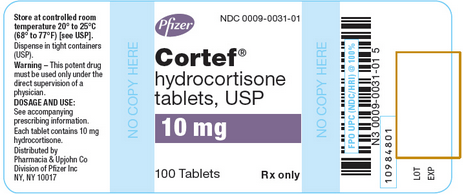
PRINCIPAL DISPLAY PANEL - 20 MG BOTTLE LABEL
NDC 0009-0044-01
Pfizer
Cortef® hydrocortisone tablets, USP
20 mg
100 Tablets Rx only
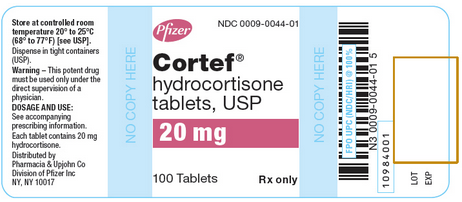
{{#ask: Label Page::Hydrocortisone (Oral) |?Label Name |format=template |template=DrugLabelImages |mainlabel=- |sort=Label Page }}
Patient Counseling Information
- Persons who are on immunosuppressant doses of corticosteroids should be warned to avoid exposure to chicken pox or measles. Patients should also be advised that if they are exposed, medical advice should be sought without delay.
Precautions with Alcohol
Alcohol-Hydrocortisone (Oral) interaction has not been established. Talk to your doctor about the effects of taking alcohol with this medication.
Brand Names
- CORTEF
Look-Alike Drug Names
There is limited information regarding Hydrocortisone (Oral) Look-Alike Drug Names in the drug label.
Drug Shortage Status
Price
References
The contents of this FDA label are provided by the National Library of Medicine.
- Pages with script errors
- Template:drugs.com link with non-standard subpage
- Drugs with non-standard legal status
- Articles with changed DrugBank identifier
- E number from Wikidata
- ECHA InfoCard ID from Wikidata
- Chemical articles with unknown parameter in Infobox drug
- Drugboxes which contain changes to verified fields
- Drugboxes which contain changes to watched fields